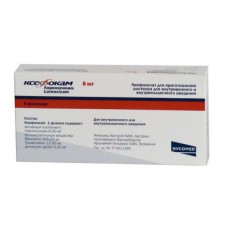Expiration date: 02/2026
The composition and form of issue:
Lyophilisate for preparation of solution for intravenous and intramuscular injection. 1 vials contains active substance:
lornoxicam 8 mg
auxiliary substances: mannitol 100 mg trometamol 12 mg disodium edetate 0.2 mg
in dark glass bottles, sealed with rubber stopper, aluminum cap nakatannyh and closed the plastic cover 5 or 10 vials with the lyophilisate, without a solvent in the cardboard pack.
Description pharmaceutical form:
A dense mass of yellow.
Pharmacokinetics:
When the/m introduction lornoxicam Cmax in plasma is approximately 0,4 h. the Absolute bioavailability (calculated on the basis of the magnitude of the AUC) after the/m introduction is 97%. T1/2, on average, is equal to 3-4 hours Lornoxicam is present in the plasma in unchanged form and in the form hydroxylated metabolite which has no pharmacological activity. The degree of binding with plasma proteins is 99% and is independent of concentration. Lornoxicam is metabolized completely, approximately 1/3 of the metabolites excreted in the urine and 2/3 in the feces. In elderly and patients with impaired liver function and kidney is not detected significant changes in the pharmacokinetics of lornoxicam.
Description pharmacological action:
Has a pronounced analgesic and anti-inflammatory effect. Lornoxicam has a complex mechanism of action, which is based on the suppression of PG synthesis due to the inhibition of the activity of isoenzymes COX 1 and 2 as in inflammation, and in healthy tissues. In addition, lornoxicam inhibits the release of oxygen free radicals from activated leukocytes.
Analgesic effect of lornoxicam is not associated with epitopically effect on CNS and, in contrast to narcotic analgesics, lornoxicam does not inhibit breathing, does not cause drug dependence.
Indications:
Pain syndrome of mild to moderate intensity (including post-operative pain, sciatica) — short-term therapy.
Contraindications:
- hypersensitivity to lornoxicam or to any of its excipients, to other NSAIDs, including acetylsalicylic acid (i.e., "aspirin" asthma)
- hypocoagulation, hemorrhagic diathesis, blood coagulation disorders, as well as the condition after surgery, risk of bleeding or incomplete hemostasis
- erosive-ulcerative lesions of the gastrointestinal tract (stomach ulcer and duodenal ulcer, ulcerative colitis) in the acute stage
- expressed violation of liver function
- moderate or severe renal dysfunction (serum creatinine >300 µmol/l)
- severe thrombocytopenia
- gastrointestinal bleeding, bleeding in the brain (including suspected)
- severe heart failure and hypovolemia
- pregnancy or breastfeeding
- the age of 18 years (insufficient clinical experience)
- the deficit glukozo-6-fosfatdegidrogenaza.
Caution: slightly expressed violation of the kidney (concentration of serum creatinine 150-300 µmol/l) asthma liver disease compensated heart failure gastrointestinal ulcers and bleeding in the anamnesis of elderly patients (65 years and older, because the decrease in clearance of lornoxicam), and patients with body weight <50 kg, and after surgery.
Side effects:
About 16% of patients (in the case of long-term treatment up to 20-25% of patients) can experience adverse reactions related to the gastrointestinal tract, 5% of patients may experience reactions related to the CNS disorders and 2% of skin reactions.
In applying the drug Xefocam may experience the following unwanted effects:
Gastrointestinal: frequent (&GE. 1% and <10%) — abdominal pain, diarrhea, nausea, vomiting, heartburn rarely (<1%) constipation, dysphagia, dry mouth, flatulence, gastritis, esophagitis, erosivno-azwenne defeat mucous membrane of the stomach and intestines and/or gastrointestinal bleeding, stomatitis, hemorrhoidal bleeding, increase in liver transaminases and alkaline phosphatase, abnormal liver function.
Skin: rarely — skin rash, bullous eruptions, eczema, polymorphic erythema, erythroderma (exfoliative dermatitis), alopecia, photosensitivity, purpura.
Hematopoietic system: rarely — thrombocytopenia, increased bleeding time, anemia, decrease in the erythrocyte count, hemoglobin and white blood cells, agranulocytosis.
SSS: rarely — the development or worsening of heart failure, increase or decrease in blood pressure, palpitations, tachycardia.
Central nervous system: often — dizziness, headache, rarely — insomnia, drowsiness, malaise, weakness, hot flashes rarely — drowsiness, dizziness, paresthesia, tremor, disturbances of taste, agitation, depression, tremor, aseptic meningitis.
Respiratory system: rarely — dyspnea, bronchospasm, cough, rhinitis.
Urinary system: rarely — dysuria, decrease glomerular filtration, increasing the concentration of urea nitrogen and creatinine in the blood, interstitial nephritis, glomerulonephritis, papillary necrosis, nephrotic syndrome, peripheral edema, acute renal failure.
Musculoskeletal system: rarely — myalgia, muscle cramps of the legs.
Sense organs: rarely — conjunctivitis, vision disorders, ringing in the ears.
Allergic reactions: rare — bronchospasm, urticaria, Stevens-Johnson syndrome, toxic epidermal necrolysis (Lyell's syndrome), allergic purpura, systemic anaphylactic reactions (including shock).
Other: rarely — loss of appetite, weight changes, increased sweating.
Local reactions: redness, soreness at the injection site.
Drug interactions:
While the use of Xefocam and anticoagulants or thrombocyte aggregation inhibitors — may increase bleeding time (increased risk of bleeding) of sulfonylureas — may increase the hypoglycemic effect of other NSAIDs — increase risk of development of adverse reactions to diuretics — decrease the effectiveness of loop diuretics and uricosuric drugs ACE inhibitors - may decrease the action of ACE inhibitors and drugs lithium it is possible to increase the maximum lithium concentration, and, therefore, may increase the adverse effects caused by lithium methotrexate and cyclosporine — increase in the concentration of methotrexate and cyclosporine in the serum mielotoksicnae drugs — strengthening gematotoksichnosti digoxin — reduced renal clearance of digoxin corticosteroids and mineralokortikosteroidov, estrogen — enhancing side effects.
Inducers of microsomal oxidation (phenytoin, ethanol, barbiturates, rifampicin, phenylbutazone, tricyclic antidepressants) reduce the concentration of lornoxicam in plasma, the inhibitors may increase the severity of side effects.
Method of application and dose:
In/in, in/m. the Solution for injection prepared immediately before use by dissolving contents of one vial (8 mg powder Xefocam) water for injection (2 ml).
After preparation of the solution replace the needle. The/m injections with a long needle.
The thus prepared solution was injected in/in or/m, postoperative pain and/m during an acute attack of lumbago/sciatica.
The duration of/the introduction of the solution should be not less than 15 s/m is not less than 5 C.
The initial dose may be 8 or 16 mg. When there is insufficient analgesic effect of a dose of 8 mg may be added the same dose.
Maintenance therapy is 8 mg 2 times a day.
The maximum daily dose should not be more than 16 mg.
Overdose:
Currently no data on overdose of the drug Xefocam, which could allow for its impacts or to suggest specific measures for their elimination.
Symptoms: however, you can assume that in the case of an overdose of the drug Xefocam side effects from the gastrointestinal tract, Central nervous system and signs of kidney failure will be more frequent and severe.
Treatment: if you suspect an overdose of the drug Xefocam should be stopped. Due to the fact that T1/2 lornoxicam — about 4 hours, he rapidly excreted from the body. This substance cannot be removed from the body using dialysis. Currently there is no specific antidote. Use ordinary emergency measures and symptomatic treatment.
Special instructions:
During treatment necessary to monitor the status of the gastrointestinal tract to prevent ultserogennogo or gastrointestinal bleeding. To reduce the risk of ulcerogenic action allows the simultaneous administration of omeprazole or H2-histamine antagonists, synthetic PG analogues (misoprostol).
During treatment needed to be monitored picture peripheral blood and functional state of the liver and kidneys.
In patients with renal insufficiency (creatinine concentration in plasma 150-300 µmol/l) require regular monitoring of kidney function.
If necessary, determine the 17-ketosteroids drug should be discontinued for 48 h before the study.
Delays in the body sodium, potassium, lithium and water, which may worsen the course of hypertension and heart failure, and in patients, taking drugs lithium, to increase the severity of side effects lithium salts.
In elderly patients, and hypertension requires regular monitoring AD.
During the period of treatment must be careful when driving and occupation of other potentially hazardous activities, require high concentration and psychomotor speed reactions.


